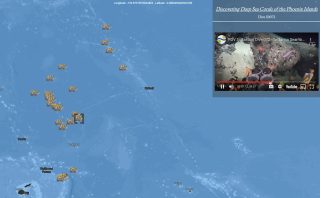The New Dive Vault
 The Dive Vault application developed by SOI’s Data Architect, Corinne Bassin, and SOI’s first Data Intern, Bailey Skinner, was created with the intention of making ROV SuBastian archival livestream dive videos more interactive and to provide geographic context for each dive.
The Dive Vault application developed by SOI’s Data Architect, Corinne Bassin, and SOI’s first Data Intern, Bailey Skinner, was created with the intention of making ROV SuBastian archival livestream dive videos more interactive and to provide geographic context for each dive.
The map displays deep sea dives performed by ROV SuBastian between 2017-2022 while onboard the R/V Falkor. All dives were live streamed and then archived through the Schmidt Ocean Institute YouTube channel.
To use Dive Vault, hover your mouse over any SuBastian dive location to access the video. Clicking on expedition titles will take you to the official expedition webpage with further information of the research that took place. To access the Dive Vault click here.
Open Source Publications
Microbial functional diversity across biogeochemical provinces in the central Pacific Ocean – Saunders J., et al., September 2022
During a 2016 expedition, Dr. Mak Saito from Woods Hole Oceanographic Institute and his team aboard R/V Falkor collected enough Ocean proteins to create the largest Ocean protein library in the world. Now the analysis of the proteins has begun, with the first publication out analyzing the presence of proteins in time and space. The library has many uses including providing insight into microbial interactions on a changing planet.
Video surveys of sea snakes in the mesophotic zone shed light on trends in populations– Speed W., et al., September 2022
In 2021, Drs. Karen Miller of the Australian Institute of Marine Science and Nerida Wilson of the Western Australian Museum sailed on R/V Falkor to explore the mesophotic zone of Ashmore Reef Marine Park off Northwestern Australia. During the expedition, they documented a number of sea snakes, many of which were thought to be locally extinct on the reef. The video surveys they collected were utilized to examine trends in seasnake populations in the mesophotic zone.
A new species of deep-sea torquaratorid enteropneust (Hemichordata): A sequential hermaphrodite with exceptionally wide lips by Holland N., Et Al., July 2022
A new species of acorn worm, Yoda demiankoopi, was recorded and collected at abyssal depths in the eastern North Pacific. One of the collections occurred aboard R/V Falkor on the 2021 expedition, Biodiverse Borderlands, led by chief scientist Dr. Lisa Levin from Scripps Institution of Oceanography. The new species of worm is a sequential hermaphrodite and alternates between spawning as female or male.
We invite you to share the newsletter with your friends and encourage them to subscribe, so they do not miss our first-look at Schmidt Ocean Institute’s activities.
Fall Newsletter 2022 • Menu
Subscribe to our quarterly newsletter
